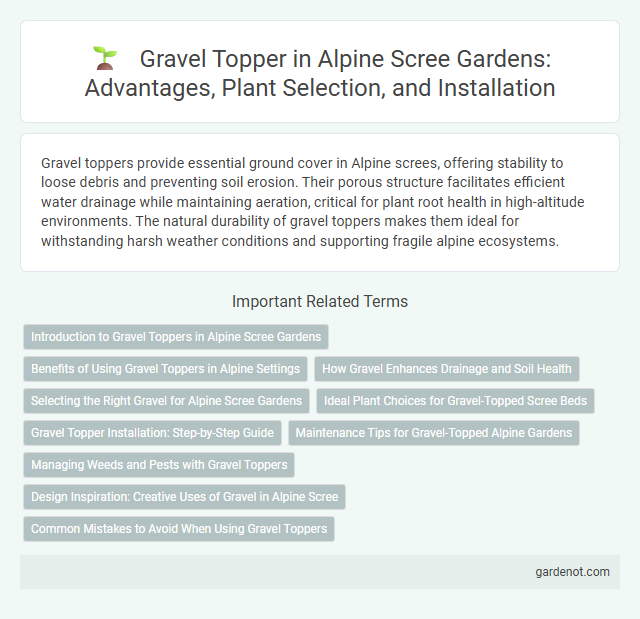Gravel toppers provide essential ground cover in Alpine screes, offering stability to loose debris and preventing soil erosion. Their porous structure facilitates efficient water drainage while maintaining aeration, critical for plant root health in high-altitude environments. The natural durability of gravel toppers makes them ideal for withstanding harsh weather conditions and supporting fragile alpine ecosystems.
Introduction to Gravel Toppers in Alpine Scree Gardens
Gravel toppers in alpine scree gardens provide essential soil stabilization and improve drainage, mimicking natural mountain environments where loose rock and gravel dominate. These coverings enhance root protection for alpine plants by preventing erosion while maintaining the airy, well-drained substrate essential for species like Saxifraga and Armeria. Selecting angular, coarse gravel improves water percolation and creates the rugged texture characteristic of authentic scree landscapes.
Benefits of Using Gravel Toppers in Alpine Settings
Gravel toppers provide effective soil erosion control in alpine scree environments by stabilizing loose rock and preventing sediment displacement during heavy rainfall and snowmelt. Their porous structure facilitates natural drainage, reducing water pooling and frost heave issues common in high-altitude terrains. Using gravel toppers enhances safety by creating stable walking and climbing surfaces for hikers and maintaining the integrity of infrastructure in rugged alpine landscapes.
How Gravel Enhances Drainage and Soil Health
Gravel topper on alpine scree significantly improves drainage by allowing water to percolate quickly through the soil, preventing waterlogging and root rot. Its coarse texture promotes aeration, enhancing soil oxygen levels essential for healthy root development. The gravel layer also stabilizes the soil structure, reducing erosion while supporting beneficial microbial activity that boosts nutrient cycling.
Selecting the Right Gravel for Alpine Scree Gardens
Choosing the right gravel for alpine scree gardens involves selecting materials that promote excellent drainage and mimic natural mountain environments. Opt for angular, coarse gravel such as crushed granite or quartzite, which resists compaction and supports plant roots while enhancing soil aeration. Particle size between 6-20 mm is ideal, balancing water retention and runoff to create optimal conditions for alpine flora.
Ideal Plant Choices for Gravel-Topped Scree Beds
Ideal plant choices for gravel-topped scree beds include drought-tolerant, low-growing species such as sedums, saxifrages, and alpine asters, which thrive in well-drained, nutrient-poor conditions. These plants exhibit deep root systems and minimal water requirements, ensuring stability and moisture retention in gravel substrate. Incorporating evergreen ground covers like creeping thyme and moss campion adds year-round texture while enhancing erosion control and aesthetic appeal.
Gravel Topper Installation: Step-by-Step Guide
Proper gravel topper installation on alpine scree involves first preparing the surface by clearing debris and leveling the area to ensure stability. Next, a geotextile membrane is laid to prevent weed growth and improve drainage beneath the gravel layer. Finally, evenly spread the gravel topper at a recommended depth of 2 to 3 inches, compacting it with a roller or plate compactor to create a durable, well-drained surface ideal for mountainous terrain.
Maintenance Tips for Gravel-Topped Alpine Gardens
Regularly remove debris and fallen leaves from gravel-topped Alpine scree gardens to prevent organic matter buildup that can promote weed growth and retain excess moisture. Periodically rake the gravel to maintain an even surface, enhancing both appearance and drainage efficiency crucial for Alpine plant health. Inspect and replenish gravel layers as needed to preserve proper soil insulation and prevent erosion in high-altitude environments.
Managing Weeds and Pests with Gravel Toppers
Gravel toppers provide an effective barrier for managing weeds in alpine scree environments by limiting sunlight penetration and reducing soil disturbance, which inhibits weed seed germination. Their coarse texture deters pest habitation and allows for better water drainage, minimizing conditions favorable for common pests. Using gravel toppers in alpine scree not only supports plant health by controlling unwanted growth but also maintains soil stability and ecosystem balance.
Design Inspiration: Creative Uses of Gravel in Alpine Scree
Gravel topper design draws inspiration from the natural textural patterns found in alpine scree, utilizing varying sizes and colors of gravel to mimic the rugged terrain. This approach enhances pathways and garden beds by integrating visually striking, low-maintenance surfaces that promote drainage and erosion control. Creative applications include layering gravel in gradient patterns and combining angular stones to replicate scree slopes, offering both aesthetic appeal and ecological functionality.
Common Mistakes to Avoid When Using Gravel Toppers
Gravel toppers can enhance Alpine scree stability but common mistakes reduce effectiveness, such as using improper gravel size that impedes drainage and root growth. Overlooking the necessity for a proper base layer causes gravel displacement and erosion, undermining surface integrity. Failure to maintain consistent thickness leads to uneven coverage, which compromises scree structure and long-term durability.
Gravel topper Infographic

 gardenot.com
gardenot.com